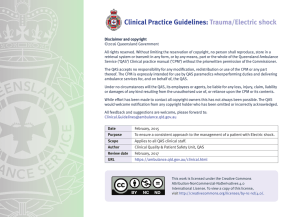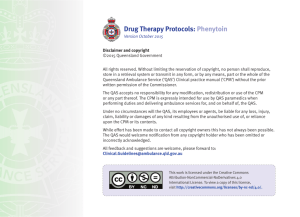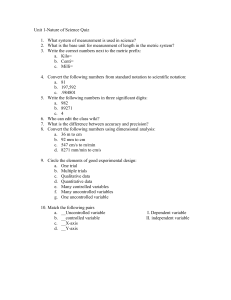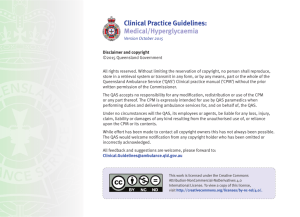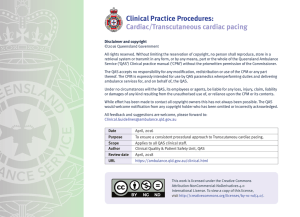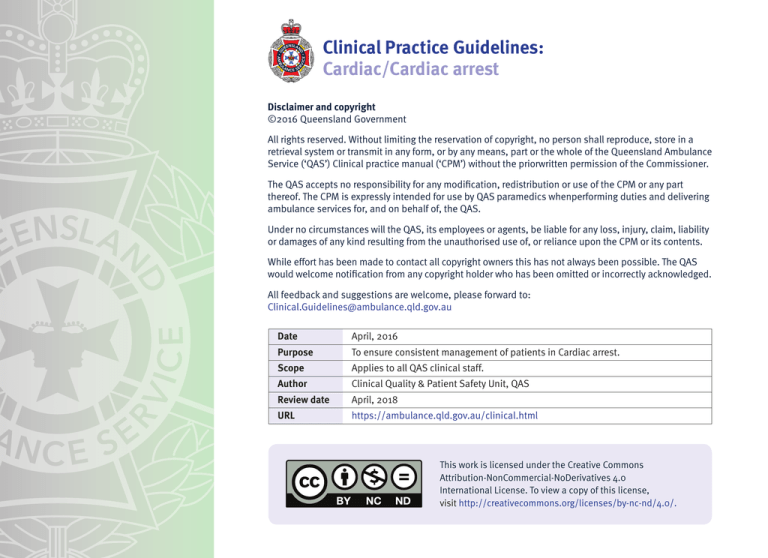
Clinical Practice Guidelines:
Cardiac/Cardiac arrest
Disclaimer and copyright
©2016 Queensland Government
All rights reserved. Without limiting the reservation of copyright, no person shall reproduce, store in a
retrieval system or transmit in any form, or by any means, part or the whole of the Queensland Ambulance
Service (‘QAS’) Clinical practice manual (‘CPM’) without the priorwritten permission of the Commissioner.
The QAS accepts no responsibility for any modification, redistribution or use of the CPM or any part
thereof. The CPM is expressly intended for use by QAS paramedics whenperforming duties and delivering
ambulance services for, and on behalf of, the QAS.
Under no circumstances will the QAS, its employees or agents, be liable for any loss, injury, claim, liability
or damages of any kind resulting from the unauthorised use of, or reliance upon the CPM or its contents.
While effort has been made to contact all copyright owners this has not always been possible. The QAS
would welcome notification from any copyright holder who has been omitted or incorrectly acknowledged.
All feedback and suggestions are welcome, please forward to:
Clinical.Guidelines@ambulance.qld.gov.au
Date
April, 2016
Purpose
To ensure consistent management of patients in Cardiac arrest.
Scope
Applies to all QAS clinical staff.
Author
Clinical Quality & Patient Safety Unit, QAS
Review date
April, 2018
URL
https://ambulance.qld.gov.au/clinical.html
This work is licensed under the Creative Commons
Attribution-NonCommercial-NoDerivatives 4.0
International License. To view a copy of this license,
visit http://creativecommons.org/licenses/by-nc-nd/4.0/.
Cardiac arrest
April , 2016
Cardiac arrest occurs when there is the cessation of blood circulation due to the inability of the heart to maintain
adequate tissue perfusion. As such, the patient may appear with no signs of life or inadequate perfusion.
Shockable
Pulseless Ventricular Tachycardia (VT) is a regular broad complex tachycardia (> 100 bpm) which
usually occurs when the pacemaker of the heart originates from a single point within a ventricle.
There are numerous different types of VT, of which monomorphic VT is the most common. Also occurring is polymorphic VT, which includes torsades de pointes. It may be sustained ( > 30 seconds) or non-sustained and may or may not result in haemodynamic instability.
UNCONTROLLED WHEN PRINTED
In cardiac arrest the heart may be in a number of different rhythms that may be classified as shockable
UNCONTROLLED WHEN PRINTED
(direct current countershock DCCS) and
non-shockable (DCCS not indicated).[1-9]
Lead II (25 mm/sec)
UNCONTROLLED WHEN PRINTED
Ventricular Fibrillation (VF) results from the rapid, irregular, asynchronous depolarisation and
contraction of multiple areas of the ventricles. As such, there is inadequate myocardial pump
function, resulting in immediate loss of cardiac output. The ECG shows irregular deflections with no
discernable P-waves, QRS complexes nor T-waves and ranges from coarse to fine in amplitude.[2,3, 5-9]
UNCONTROLLED WHEN PRINTED
Lead II (25 mm/sec)
Figure 2.7
QUEENSLAND AMBULANCE SERVICE
56
Non-shockable
Pulseless Electrical Activity (PEA) is the occurrence of organised electrical activity on the ECG with no resulting detectable cardiac output (there is no palpable pulse). In true PEA, the heart does not show cardiac contractions. Pseudo-PEA however, may demonstrate
some cardiac wall motion, without adequate cardiac output to produce a palpable pulse. Reversible causes of this arrhythmia should be sought. The rhythms associated with PEA are numerous, however the most frequent include sinus bradycardia, junctional and
idioventricular rhythms.
UNCONTROLLED WHEN PRINTED
Sinus bradycardia
Junctional
Idioventricular
UNCONTROLLED WHEN PRINTED
Lead II (25 mm/sec)
Lead II (25 mm/sec)
Lead II (25 mm/sec)
Asystole is the absence of cardiac electrical activity with concomitant myocardial standstill and no cardiac output.
UNCONTROLLED WHEN PRINTED
UNCONTROLLED WHEN PRINTED
Lead II (25 mm/sec)
QUEENSLAND AMBULANCE SERVICE
57
Clinical features
• There are no signs of life:
CPG:
safety
CPG: Paramedic
Paramedic Safety
CPG:
cares
CPG: Standard Cares
- unresponsive
UNCONTROLLED WHEN PRINTED
- not breathing normally
- carotid pulse cannot be confidently palpated within 10 seconds, OR
• There are signs of grossly inadequate
perfusion:
Manage as per appropriate CPG:
Traumatic cardiac arrest?
- unresponsive
N
• CPG: Resuscitation – Adult
• CPG: Resuscitation – Paediatric
• CPG: Resuscitation – Newly born
UNCONTROLLED WHEN PRINTED
- pallor or central cyanosis
- inadequate pulse
Y
- < 40 bpm in a child/adult (≥ 1 years)
- < 6o bpm in an infant (< 1 year)
- < 100 bpm in a newly born
Manage as per:
Note: Officers are only to perform
procedures for which they have
received specific training and authorisation by the QAS.
UNCONTROLLED WHEN PRINTED
Risk Assessment
• CPG: Resuscitation – Traumatic
• Not applicable
UNCONTROLLED WHEN PRINTED
e
Additional information
• If there is any uncertainty CPR should be commenced.
QUEENSLAND AMBULANCE SERVICE
58

